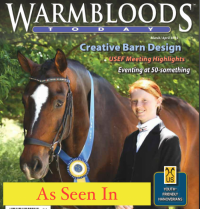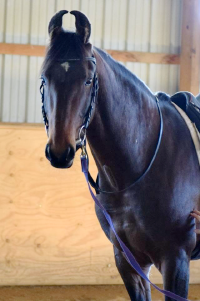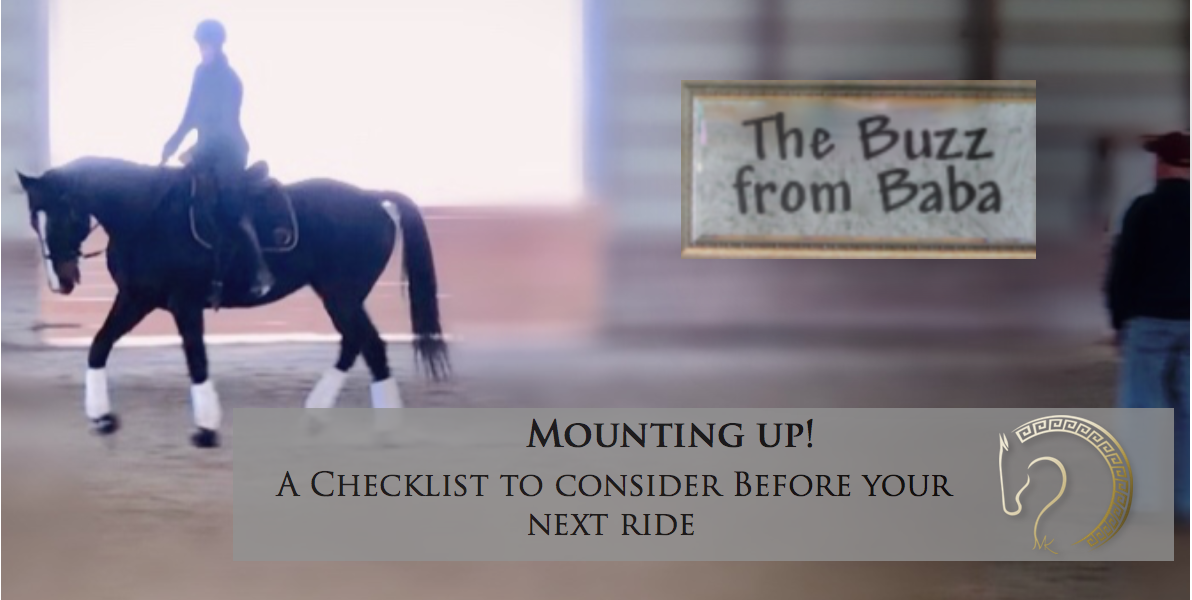 This article was originally published in Warmbloods Today in the column titled Warmblood Whispers
This article was originally published in Warmbloods Today in the column titled Warmblood Whispers
This month’s reminder from Baba has to do with — Mounting up!
Every airplane flight requires that its pilots conduct a pre-flight check. This necessary and potentially life-saving procedure consists of a thorough and rather monotonous review of flight systems before take-off.
Presented below are seven steps that you can apply as an everyday pre-ride checklist before mounting your own horse, someone else’s horse or before you are about to plunge into a trail ride in unfamiliar territory. Consider that getting on a horse takes courage, skill and tact since these animals have one of the largest amygdalae of all mammals. In other words, your horse has an innate heightened flight response. This checklist is so obvious that we oftentimes overlook these simple but vital factors. Ask yourself if you are really using these checkpoints every single day, every single ride? It’s one thing to believe in it, another to apply it. There are some definite factors you would want to consider, at minimum, before you put on your helmet and step in the stirrup.
Ask yourself, ‘do I feel safe here?’
The Trust Factor
Our instincts were meant to protect us. Learning to honor that little voice in your head that tells you whether to go towards something or away from it is invaluable. Much
of our socialization tends to muffle that instinct. An early example is seen in young children who may be forced to eat—to finish their plate of food—when they say they are full. Early on the lesson learned is to ignore our bodily sensations of fullness. So it is no
wonder then that, as an adult, one may question that still voice in one’s head. We are conditioned to silence it and defer to compliance. Learning to be honest about your sense of a particular horse or situation is the first step.
Are we together? Are we one?
The Togetherness Factor
Generally, if you have to ask this question it means you don’t have it. But being honest about that is a good start. General signs that there is a lack of togetherness include a loss of rhythm and distractability, among others. Sad, but much too commonly found, is the use of contraptions that keep the horse’s head set and artificially give the false picture of focus. This masks the underlying reason of why the togetherness factor is suffering. Have you ever been on a horse but had the feeling that no one was home? It can be a terrifying and disconnecting feeling to sit atop an animal and feel that she or he is not with you. Cultivating a respect for primitive instincts can warn and protect you. But people tolerate lack of togetherness because they don’t know what it feels like when it really exists. And that is sometimes not just with horses.
“We need to be in a simple, more innocent, ‘childlike’ space with our horses—a place so clear and so beautiful that just being there with them offers us purity.”
The Soundness Factor
One of the best investments one can make in his or her journey to develop horsemanship skills is to continually learn about the horse’s locomotion and physiology. Subtle suggestions of soundness issues are commonly never detected because the person atop the horse or on the end of the lunge line has not developed an eye for this.
“Sad, but much too commonly found, is the use of contraptions that keep the horse’s head set and artificially give the false picture of focus. This masks the underlying reason of why the togetherness factor is suffering.”
Working with a professional on the basics of the horses’ footfall is key. Learning advanced lunging skills also provides an excellent vantage point to begin to develop an eye and feel that your horse may be off, especially for riders who are not advanced enough under saddle to feel a disturbance. The soundness of your tack is also paramount. We take for granted the reliability of something we use every day. Make it a habit to do a quick sweep of the integrity of your tack.
Assess his physical capability for the day
The Physicality Factor
The in-handwork is used to prepare us for the ride, but it is also a key opportunity to evaluate his soundness and establish togetherness as well. For example, the in-hand
use of the three- or four-track shoulder-in can provide crucial information so that you can customize your ride, which prevents disturbing the horse and creating or
perpetuating resistances under saddle.
Is he mentally and physically comfortable?
The Comfort Factor
The horse’s happiness must be the rider’s primary concern. Two things that I find block the horses wellness are that signs of resistance are often overlooked as markers of
physical and/or mental distress and that riders overdo an exercise and don’t know when to stop. An example I see often is that of one taking restraints, such as side reins, off after a brief lunging and all of a sudden the horse explodes under saddle. Remember, lack of exuberance in the horse is not necessarily compliance and physical balance is necessary for mental connection. When the horse’s balance is threatened, he is not listening to us—he reacts in fear. But when the horse is physically balanced, then we have a chance to establish a mental balance. We can help the horse stay balanced, generally, by being, rather than doing.
“We must invite the horse into a position where he is able to dance.”
The You Factor
Check yourself. Are you really open to your horse? Are you accepting him for where he is on that day? Or are you on an agenda? Are you attached to a strong image of what your ride should be or are you also open to what your horse has to offer? Are you riding for today or are you trying to replicate the ride of yesterday and not in a place to receive what he has to offer today? When we are not present, we are not even part of the picture. This is often the case—and that is why most horses look sleepy, bored or both! Are you clear with him about what you wish? The more the rider has clarity of mind, the better the ride. One needs to be as clear as possible in one’s communication to the horse so he is able to know what is desired of him. The synthesis of these two elements—not upsetting the horse and clarity of mind—produce the great feeling on horseback that we desire.
“There’s a subtle yet powerful difference between working toward a result and thinking and feeling toward
it”.-Gregg Braden
The Energy Factor
Assess our own energy. Recognize that this is one of our responsibilities. Assessing your horse’s energy is a given. If he is full of exuberance, for example, are we willing to take it or squash it? It is important to assess our own levels as part of our pre-ride check. Imagine that you have a horse that hovers around a “3” (0 is no exuberance and 10 is high). If you are feeling tired, depressed or distracted, you are probably on the lower end of the rating scale yourself. To generate a beautiful working trot or a magnificent canter, you will need a lot more inner energy. Otherwise, what typically happens is that people resort to pushing on the horse with leg pressure or even use of spurs to mechanically produce forward energy. I have a trampoline in the corner of the arena that I find useful in generating endogenous (internal) energy. When my ratings are low, a few seconds of jumping up and down can do wonders about getting all those molecules moving around!
Remember, the horse is ready for us. His state is pure.
Photos credits: Standardbred horse, Tagyoureit, guardians Stew and Lisa Goldberg
Creating the ultimate dance partner does mean that there is a certain level of physical as well as mental fitness that would ensure that our partner can easily carry us. The more we consider his comfort the more likely that this genuine regard will be heartfelt. And that is when offerings and miracles happen!
Follow along on this post board for training tips and encouragement about creating the ultimate dance partner! You can also find us using the social media links.
Meet Baba the Marwari Stallion

Baba is the inspiration for gathering and sharing reflections that we hope can help in your connection to your horse.
Here are some facts about Baba and the Marwari horse: His name means “brave one” in Hindi. Bahadurshah, or “Baba” is a Marwari horse, one of the rarest equine breeds in existence. Through his partnership with his owner, Dr. Maria Katsamanis, the bay stallion is helping promote his breed and equine-based education, as well as call attention to animal welfare around the world. There are less than 1,000 in the world like him and fewer than 30 that live outside of India.
Descending from India’s war horses, his ancestors were the chosen breed of the nobility. Though built of average size, his exotic heritage comes sharply into view with an upward glance at his ears, which curl inwardly until their tips touch. Thus the name, the “Heart shaped eared horses of India.”


